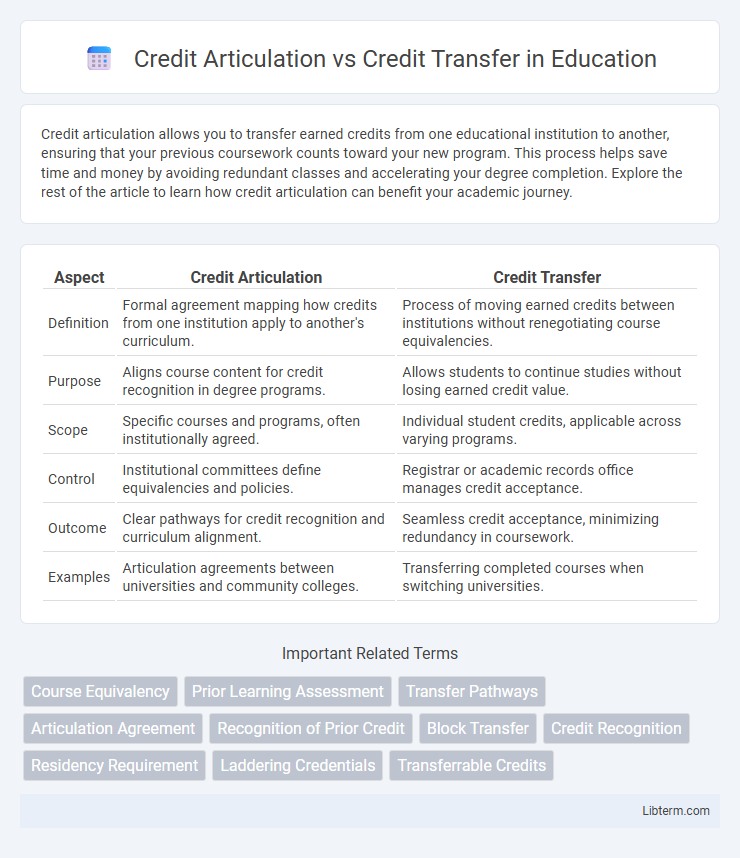Credit articulation allows you to transfer earned credits from one educational institution to another, ensuring that your previous coursework counts toward your new program. This process helps save time and money by avoiding redundant classes and accelerating your degree completion. Explore the rest of the article to learn how credit articulation can benefit your academic journey.
Table of Comparison
| Aspect | Credit Articulation | Credit Transfer |
|---|---|---|
| Definition | Formal agreement mapping how credits from one institution apply to another's curriculum. | Process of moving earned credits between institutions without renegotiating course equivalencies. |
| Purpose | Aligns course content for credit recognition in degree programs. | Allows students to continue studies without losing earned credit value. |
| Scope | Specific courses and programs, often institutionally agreed. | Individual student credits, applicable across varying programs. |
| Control | Institutional committees define equivalencies and policies. | Registrar or academic records office manages credit acceptance. |
| Outcome | Clear pathways for credit recognition and curriculum alignment. | Seamless credit acceptance, minimizing redundancy in coursework. |
| Examples | Articulation agreements between universities and community colleges. | Transferring completed courses when switching universities. |
Understanding Credit Articulation and Credit Transfer
Credit articulation involves a formal agreement between educational institutions allowing students to transfer earned credits from one program to another, ensuring smooth progression toward a degree. Credit transfer refers to the process of recognizing and accepting previously completed coursework for credit within a new institution or program, often subject to evaluation and equivalency assessment. Understanding these mechanisms helps students maximize earned academic credits while minimizing duplicated coursework during transitions between institutions or programs.
Key Differences Between Credit Articulation and Credit Transfer
Credit articulation involves a formal agreement between educational institutions that specifies how completed coursework and credits from one program can be applied toward a related program at another institution. Credit transfer refers to the process where students move individual course credits from one institution to another, subject to evaluation and acceptance by the receiving institution. The key differences lie in credit articulation's predefined agreements guaranteeing credit recognition, whereas credit transfer depends on case-by-case assessment without prior standardized arrangements.
Benefits of Credit Articulation for Students
Credit articulation allows students to seamlessly continue their education by mapping completed coursework to specific program requirements at a new institution, ensuring efficient progression toward degree completion. This process reduces redundancy in learning, saving time and tuition costs by avoiding repeated courses. Furthermore, credit articulation enhances academic planning and clarity, helping students make informed decisions about transferring credits to maximize their educational investment.
Advantages of Credit Transfer in Higher Education
Credit Transfer in higher education enables students to apply previously earned credits from one institution toward a degree at another, streamlining academic progression and saving valuable time. This process enhances flexibility by allowing learners to customize their education across various institutions without redundant coursework. Moreover, Credit Transfer supports student mobility and reduces overall educational costs by minimizing the need to retake equivalent courses.
Common Challenges in Credit Recognition
Common challenges in credit recognition between credit articulation and credit transfer include discrepancies in curriculum alignment, varying accreditation standards, and differences in grading scales across institutions. These factors often result in inconsistent credit equivalency decisions, complicating students' academic progress and credit accumulation. Institutions must navigate complex policies and communication gaps to ensure fair and transparent credit recognition processes.
Institutional Roles in Credit Articulation and Transfer
Institutions play a crucial role in credit articulation by evaluating and aligning course content, ensuring that credits earned at one institution meet the academic standards and requirements of another. In credit transfer, institutions facilitate the acceptance of previously earned credits into degree programs, often relying on formal agreements and standardized policies to maintain academic integrity. Institutional collaboration and clear communication are essential to streamline processes and support student mobility across educational systems.
Impact on Student Mobility and Academic Progression
Credit articulation agreements facilitate seamless student mobility by clearly defining how specific course credits transfer between institutions, ensuring academic progression without loss of credits. Credit transfer processes impact student mobility by determining the acceptability of previously earned credits, which can either accelerate or delay degree completion based on institutional policies. Understanding the distinctions between credit articulation and credit transfer is essential for optimizing academic pathways and minimizing barriers to student advancement.
Policies Governing Credit Articulation and Transfer
Policies governing credit articulation and credit transfer ensure consistent evaluation standards between educational institutions, facilitating student mobility and academic progress. Credit articulation focuses on predefined agreements outlining specific course equivalencies, while credit transfer policies address the acceptance of previously earned credits based on institutional criteria such as accreditation, course content, and grade requirements. Effective governance includes transparency, documentation, and alignment with national qualification frameworks to uphold academic integrity and support seamless transition pathways.
Best Practices for Seamless Credit Transition
Best practices for seamless credit transition involve clearly defined credit articulation agreements that specify course equivalencies and learning outcomes between institutions, ensuring students receive appropriate credit recognition. Detailed transcript evaluations and collaboration between academic advisors help maintain academic integrity while streamlining credit transfer processes. Utilizing standardized assessment criteria and proactive communication between sending and receiving institutions minimizes credit loss and accelerates degree completion.
Future Trends in Academic Credit Systems
Future trends in academic credit systems emphasize increased integration of credit articulation and credit transfer through blockchain technology, enhancing transparency and security in credit recognition. Artificial intelligence-driven platforms are expected to personalize credit evaluation, facilitating seamless student mobility across institutions and international borders. Collaborative frameworks among universities aim to standardize credit equivalencies, promoting global academic interoperability and lifelong learning pathways.
Credit Articulation Infographic

 libterm.com
libterm.com